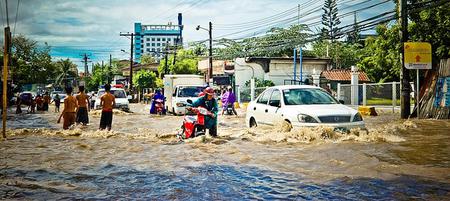AlreadyPrepared.com
Crisis & Emergency Management
Emergency Preparedness & Planning
Crisis & Emergency Management - Issues - Safety
Security - Strategies - Solutions - Resources
Crisis Management 101
Crisis management is the process by which an organization deals with a disruptive and unexpected event that threatens to harm the organization or its stakeholders. Rather than reacting in a chaotic manner, effective crisis management is proactive and strategic, aiming to minimize damage and restore operations as quickly as possible.
Phases of crisis management
A crisis can be broken down into distinct stages, from early detection to the post-crisis assessment.
Pre-crisis: Before an incident occurs, focus on prevention and preparation. Activities include conducting risk assessments, monitoring for warning signs, and building a resilient organization.
Crisis response: This is the execution phase where the crisis management plan is activated. The primary goals are to contain the damage, ensure business continuity, and communicate effectively with all stakeholders.
Post-crisis: After the immediate threat is contained, the focus shifts to recovery and learning. This involves evaluating the response, updating plans, and restoring normal operations.
Key steps for effective crisis management
An effective crisis management plan is detailed, tested, and flexible enough to adapt to unique circumstances.
Form a crisis management team. Assemble a multidisciplinary team with members from departments like operations, legal, human resources, and communications. Define specific roles and responsibilities for each team member.
Conduct a risk assessment. Identify potential crises and their likelihood, from natural disasters and technological failures to financial losses and organizational misconduct. Analyze the potential impact of each risk on your business.
Develop a detailed response plan. For high-probability risks, create step-by-step procedures to guide your team. This includes establishing a chain of command and outlining specific actions each person will take.
Create a crisis communication plan. This is a critical component of the overall management plan that focuses specifically on messaging.
Appoint a spokesperson to be the official voice of the organization.
Develop key messages for different audiences, including employees, customers, and the media. Messages should be clear, consistent, and honest.
Identify communication channels for both internal and external communication, such as mass texts, social media, and press releases.
Train and conduct drills. Practice your crisis plan regularly through mock drills and simulations to ensure the team is prepared to act quickly and effectively under pressure. Test communication protocols and identify any gaps in the plan.
Evaluate and update regularly. After a crisis or a drill, conduct a post-action review to document lessons learned. Update your plan based on this feedback to improve your response capabilities for the future.
Benefits of proactive crisis management
Investing time and resources into crisis preparedness offers significant advantages that help protect an organization's future.
Minimizes impact: A well-rehearsed plan can limit financial damage, reduce operational downtime, and minimize lost productivity when an incident occurs.
Protects reputation: Swift, transparent, and coordinated communication can protect brand reputation and build stakeholder confidence.
Ensures business continuity: By anticipating challenges, an organization can maintain critical business functions and ensure a faster recovery.
Builds employee confidence: When employees know there is a plan to protect them, it can reduce stress and improve morale during uncertain times.
Ensures legal and regulatory compliance: Proper planning can help mitigate potential legal exposure and ensure the organization meets mandatory industry regulations.
Challenges Business & Organizations
Face During A Crisis
Organizations and business face numerous and interconnected challenges during a crisis, spanning communication, operations, decision-making, and reputation. Crises disrupt standard business functions, place immense pressure on leadership, and can inflict lasting damage if mismanaged.
Communication and information challenges
Information overload and scarcity: In the early stages of a crisis, organizations often experience a flood of raw, unverified data, making it difficult to discern what is relevant.
Simultaneously, they may lack critical information needed to make informed decisions.
Rapidly evolving narrative: The 24/7 news cycle and social media mean that a crisis can develop and escalate in minutes.
Information, and often misinformation, can spread uncontrollably, making it difficult for an organization to manage the public narrative.
Communication breakdowns: Existing communication channels can be disrupted or become overwhelmed during a crisis. If the crisis management team is not well-coordinated, inconsistent or conflicting messages may be sent, causing confusion and eroding trust.
Mismanaging internal communication: Organizations often neglect to communicate effectively with their own employees. A lack of transparency can cause internal uncertainty, panic, and rumors, negatively impacting staff morale and productivity.
Operational challenges
Business continuity: A crisis can interrupt supply chains, production schedules, and other daily operations, making it difficult to maintain normal business functions. Organizations must quickly adapt by implementing new processes, such as enabling remote work, often with limited time and resources.
Inefficient resource allocation: During a disaster or mass casualty event, organizations must make rapid decisions about how to allocate limited resources, including personnel, equipment, and finances. A lack of preparation can lead to delays and inefficiency.
Insufficient infrastructure: A natural disaster, cyberattack, or other event can damage or overload technological infrastructure, including communication and IT systems. This disrupts internal and external information flow and can jeopardize security.
Leadership and decision-making challenges
Uncertainty and high stakes: Leaders are forced to make high-stakes decisions quickly with limited or imperfect information.
This can cause a high degree of stress and increases the risk of making a wrong decision.
Balancing stakeholder pressure: Leaders must manage the expectations of diverse stakeholders, including employees, customers, investors, and regulators. Trying to satisfy conflicting demands can complicate decision-making and lead to ethical dilemmas.
Moral and ethical dilemmas: A crisis can present complex ethical challenges. For example, a hospital might face decisions about allocating scarce medical resources, or a company might have to choose between employee safety and operational continuity.
Reputational and financial challenges
Loss of public trust: If a crisis is handled poorly, public perception can become overwhelmingly negative, causing a widespread loss of trust and credibility. Public outrage, amplified by social media, can quickly damage a brand's reputation.
Financial losses: A crisis can lead to a drop in stock prices, decreased sales, and long-term damage to market share.
Mishandling a crisis can also result in costly regulatory fines and litigation.
Damage to long-term brand value: A reputation crisis can have a lasting negative impact on a company's brand, a valuable intangible asset. The effort to rebuild trust and restore brand value can be a long and difficult process.
Emergency Management 101
Emergency management strategies follow a continuous cycle of four interconnected phases: mitigation, preparedness, response, and recovery. Effective strategies across these phases require robust communication, coordination, and an "all-hazards" approach to address diverse threats.
The four phases of emergency management
1. Mitigation: Reducing risks before a disaster
Purpose: To eliminate or reduce the impact and risk of hazards before an emergency occurs.
Key strategies:
Comprehensive risk assessments: Identify potential hazards a community faces, such as floods, wildfires, or other disasters, and evaluate its specific vulnerabilities.
Resilient infrastructure: Invest in improvements like reinforcing buildings with seismic retrofitting, installing flood barriers, and enforcing strict building codes in disaster-prone areas.
Risk reduction measures: Implement specific strategies, such as building on higher ground in flood zones or securing furniture to walls in earthquake-prone areas.
2. Preparedness: Planning for the event
Purpose: To develop plans and organize resources to ensure a swift and effective response.
Key strategies:
Emergency planning: Create comprehensive emergency plans (CEMPs) that outline procedures, identify critical facilities, and include logistical details like transportation routes and resource distribution.
Training and exercises: Conduct training sessions and realistic simulations to test response capabilities and help teams—including first responders and community groups—learn to coordinate under pressure.
Supply management: Strengthen systems for storing and tracking emergency supplies like food, water, medical kits, and backup power equipment.
Individual readiness: Educate the public on creating individual emergency kits, making family communication plans, and knowing evacuation routes. Special consideration should be given to vulnerable populations, including the elderly, people with disabilities, and low-income families.
3. Response: Taking immediate action during a crisis
Purpose: To save lives, protect property, and meet the basic needs of affected populations.
Key strategies:
Communication: Implement reliable communication systems and protocols to disseminate alerts, provide updates, and coordinate with internal and external agencies. Real-time data and mapping tools can enhance situational awareness.
Coordination and collaboration: Work across agencies and departments to ensure a cohesive and well-organized effort. Use a command structure to assign clear roles and responsibilities.
Flexibility: Adapt and modify response plans as the situation evolves. No plan is perfect, so teams must be prepared for unexpected challenges.
Prioritized response: Immediately after a disaster, perform a damage assessment to prioritize critical functions, allocate resources, and support employees.
4. Recovery: Restoring normalcy after a disaster
Purpose: To return the affected community to normal or near-normal conditions.
Key strategies:
Rebuilding efforts: Restore basic services and repair damaged infrastructure, such as roads and bridges. This phase also includes long-term rehabilitation.
Financial assistance: Provide aid to individuals and governments affected by the disaster.
Community support: Offer psychological first aid and other support services to help people cope with the disaster's emotional and mental health impacts.
Integration with mitigation: Use the recovery period to assess what worked and what didn't. Update plans and make improvements to infrastructure to reduce future risks.
Key components for an effective strategy
Regardless of the specific phase, the following components are vital for any emergency management strategy:
Communication plans: Establish clear internal and external communication protocols for alerts, instructions, and public information.
Resource management: Maintain a comprehensive inventory of emergency supplies, equipment, and personnel, ensuring they can be allocated efficiently during a crisis.
Training and exercises: Regularly train staff and the public and conduct drills to test the emergency plan and improve response.
Flexibility: Build contingency options into plans, allowing for quick adaptation to rapidly changing circumstances during a disaster.
Inclusive planning: Develop strategies that address the specific needs of vulnerable populations, such as seniors, children, and people with disabilities, to ensure equitable support.
Challenges Of Implementing
Emergency Management Measures
Implementing emergency management strategies is difficult due to significant challenges across all four phases of the emergency cycle: mitigation, preparedness, response, and recovery. These issues can involve financial limitations, coordination failures, and human behavioral factors.
Mitigation and preparedness challenges
Insufficient and inconsistent funding: Emergency management programs often operate with limited budgets, which restricts their ability to invest in essential mitigation projects, staff, equipment, and training. A lack of investment in proactive mitigation efforts can lead to higher costs during the response and recovery phases.
Public apathy and complacency: Public engagement in preparedness is often low. Some people who have experienced past disasters may grow complacent or dismiss warnings, while others may simply lack the motivation to prepare. This public disinterest undermines community-wide resilience.
Climate change and evolving hazards: Climate change is increasing the frequency and intensity of natural disasters, creating new and greater threats that require emergency managers to constantly re-evaluate and update their strategies. The scale of these events often outpaces traditional resources.
Limited resources and planning: In the face of ongoing budget constraints, agencies are often asked to do more with less. Inadequate staff, facilities, and technology infrastructure can weaken preparedness and response capabilities, especially for larger, more complex incidents.
Response challenges
Coordination and interoperability failures: During a multi-agency response, problems often arise from conflicting organizational goals, incompatible communication systems, and unclear chains of command. This can lead to disorganized efforts, resource misallocation, and confusion.
Communication breakdowns: Effective communication can fail due to technical issues, information overload, or a lack of compatible systems between responding agencies.
Communicating clearly with the public is also difficult due to language barriers, misinformation on social media, and disruptions to traditional channels.
Lack of unified command: Without a clear incident command system (ICS), multiple authorities can issue conflicting instructions and duplicate efforts, hampering the effectiveness of the overall response. Political pressures during a crisis can further complicate decision-making.
High-stress decision-making: The dangerous, uncertain, and high-pressure nature of emergencies can impair the judgment of emergency managers, leading to stress, fatigue, and errors in decision-making.
Recovery challenges
Inequitable disaster relief: Social and economic inequalities can lead to disproportionate impacts on marginalized and vulnerable communities, who often receive less support during recovery. Issues include language barriers, limited access to resources, and policies that favor wealthier areas.
Legal and policy hurdles: Complex regulations and bureaucratic red tape can slow down and obstruct recovery efforts. Varying rules between different government levels and agencies can also hinder the distribution of resources.
Mission creep: Emergency managers often face pressure to handle issues outside of their traditional disaster response duties, such as homelessness or drug epidemics, especially during the long recovery phase. This overextension of responsibilities can dilute their focus and effectiveness.
Ethical dilemmas: The reality of limited resources forces emergency managers to make difficult ethical decisions, such as which areas or assets to prioritize for recovery. These choices can have profound consequences for affected communities and cause moral distress for decision-makers.










